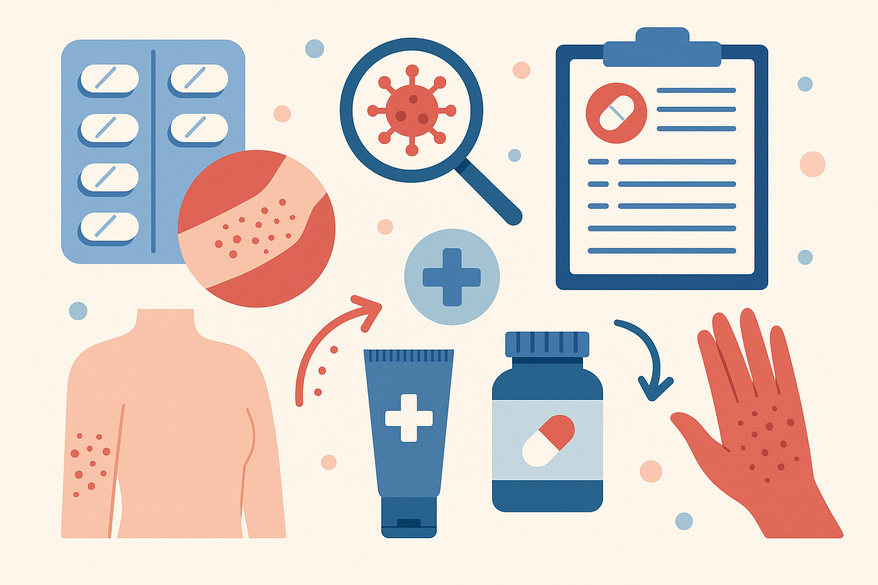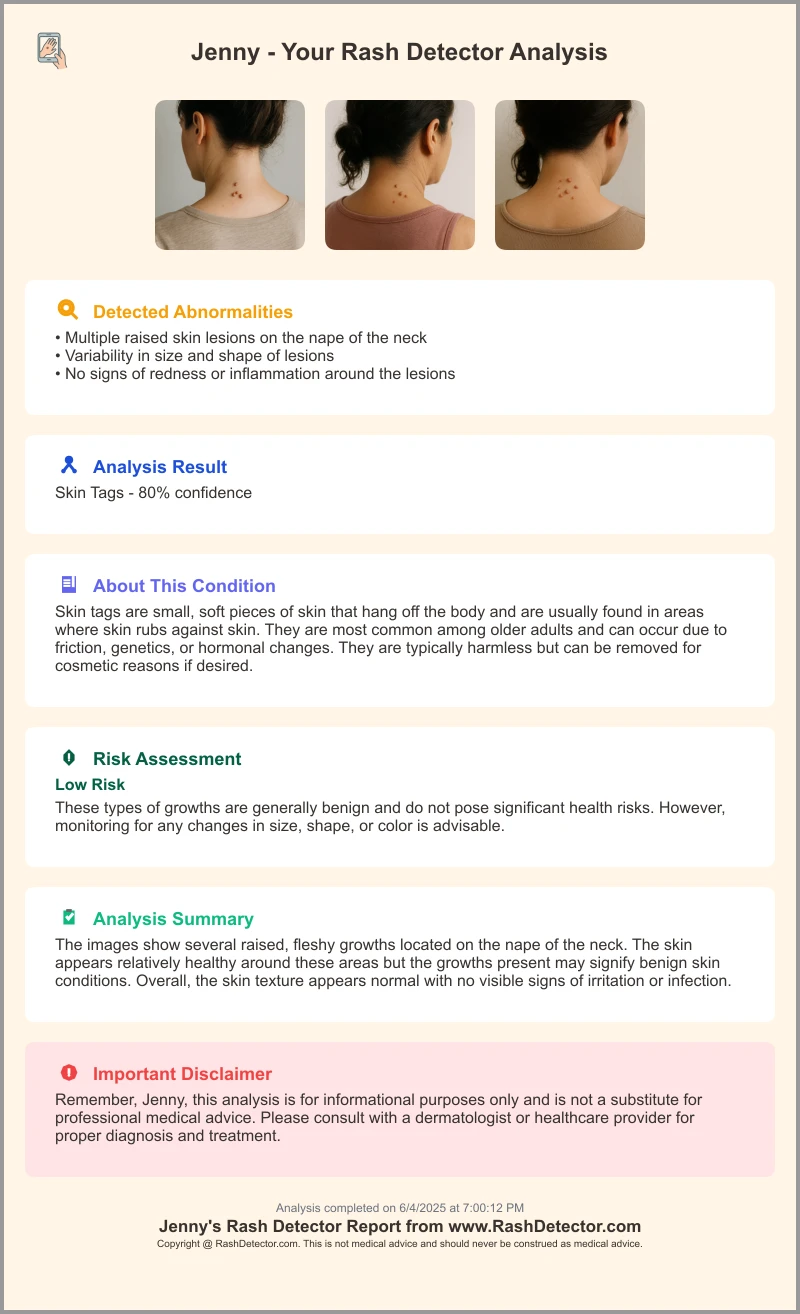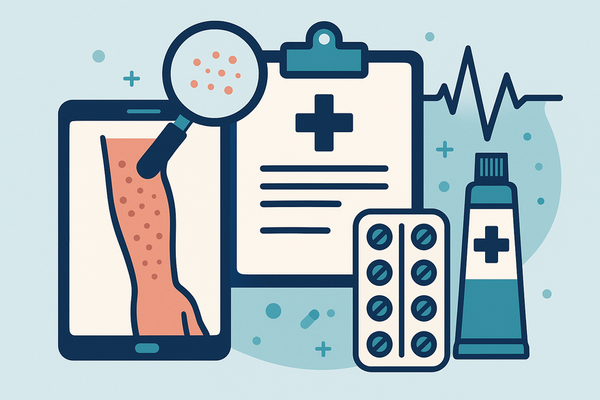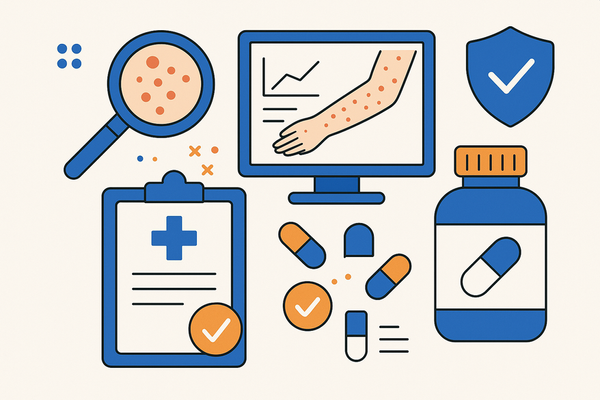Medication Rash Treatment: Comprehensive Guide to Identify, Diagnose, and Manage
Explore effective medication rash treatment, identifying causes, symptoms, and management strategies for quick relief and improved healing.

Estimated reading time: 8 minutes
Key Takeaways
- Medication-induced rashes can range from mild irritation to life-threatening reactions.
- Early recognition and differentiation between allergic and non-allergic causes guide effective treatment.
- Immediate management includes discontinuing the culprit drug and providing supportive care.
- OTC remedies (antihistamines, topical corticosteroids) and prescription therapies (oral steroids, epinephrine) address symptoms.
- Prevention and clear patient–provider communication minimize future rash risks.
Table of Contents
- 1. Understanding Medication Rashes
- 2. Identifying a Medication Rash
- 3. Diagnostic Process
- 4. Medication Rash Treatment
- 5. Managing and Monitoring the Condition
- 6. Prevention and Future Considerations
- Conclusion
1. Understanding Medication Rashes
1.1 Causes of Medication-Induced Rashes
Allergic versus non-allergic mechanisms explain why rashes occur:
- Allergic reactions involve the immune system, where antibodies react to a drug, causing hives, swelling, or anaphylaxis.
- Non-allergic side effects occur when the medication directly irritates skin cells or alters skin chemistry.
Key points:
- Immune-mediated reactions often appear quickly as hives or intense itching.
- Pharmacologic side effects may develop gradually as dryness, red patches, or mild irritation.
- Identifying the underlying cause guides the right treatment and management plan.
Source: Harvard Health Blog and Mayo Clinic
2. Identifying a Medication Rash
2.1 Recognizing the Signs
Watch for sudden skin changes after starting or adjusting a drug:
- Hives or welts on arms, chest, or back
- Red bumps forming a measles-like pattern
- New itching or burning sensations
- Rapid spread over large areas
Tip: Keep a log of new medications and symptom onset to guide early treatment. For photo tracking, consult rash tracking tips.
2.2 When to Seek Medical Advice
Red-flag signs requiring urgent care:
- Difficulty breathing or wheezing
- Swelling of the face, lips, or tongue
- Lightheadedness due to low blood pressure
- Raw or peeling skin with large blisters
- Severe mucosal ulcers in the mouth or eyes
- High fever accompanying the rash
If any of these occur, seek emergency care immediately.
Source: Children's National Medical Center
2.3 Timeline of Rash Appearance
- Immediate reactions: within minutes to hours (e.g., hives).
- Early reactions: 1–3 days after drug start (urticaria).
- Delayed reactions: 4–14 days later (morbilliform eruptions, fixed drug eruptions).
Knowing the timeline helps pinpoint the culprit and speeds up treatment.
Source: Harvard Health Blog
3. Diagnostic Process
3.1 Clinical Assessment
Clinicians diagnose based on:
- Detailed history: start date, dose changes, associated symptoms
- Medication review: prescriptions, OTC drugs, supplements
- Symptom diary: dates, photos, descriptions
Action Tip: Encourage patients to snap smartphone photos for clearer assessment and tailored care. Use the Rash Detector app to upload images and receive an AI-generated report.

3.2 Laboratory and Biopsy Tests
For severe or unclear cases:
- Skin biopsy: identifies cell types and rules out infection
- Blood tests: CBC, liver function tests, eosinophil count (e.g., for DRESS syndrome)
Confirmatory tests refine the treatment plan.
Source: NYU Langone Health
3.3 Reviewing Medication History
Checklist:
- All current and new prescriptions
- Recent dose increases
- Herbal supplements and vitamins
- History of rashes or allergies
Be aware of cross-reactivity (e.g., penicillins vs. cephalosporins) when selecting safe alternatives. For more details, visit drug-induced rash recognition.
4. Medication Rash Treatment
4.1 Immediate Management Steps (Under Supervision)
- Discontinue the suspected drug under clinical guidance—do not stop essential medicines without approval.
- Switch to an alternative if available (use allergy-friendly substitutes).
- Monitor vital signs if systemic symptoms are present.
- Keep the skin clean and dry to prevent infection.
Prompt action is the foundation of effective treatment.
4.2 Over-the-Counter Remedies
Antihistamines:
- Cetirizine 10 mg once daily—relief in 1–2 hours
- Diphenhydramine 25 mg every 6 hours—for nighttime itching
Topical corticosteroids:
- Hydrocortisone 1% cream—apply a thin layer twice daily
- Avoid use on thin skin (face, groin) for more than 7 days
These OTC options offer quick symptom relief.
4.3 Prescription Treatments
Oral corticosteroids:
- Prednisone taper over 7–14 days for moderate to severe eruptions
- Example: 40 mg daily for 3 days, then reduce by 5 mg every 2 days
Epinephrine auto-injector:
- 0.3 mg intramuscular injection for anaphylaxis
- Carry at all times if there is a history of severe reactions
Hospitalization and IV steroids:
- Required for Stevens–Johnson syndrome or toxic epidermal necrolysis
- High-dose IV methylprednisolone or cyclosporine in an ICU setting
4.4 Alternative and Adjunctive Approaches
- Cool compresses (15 minutes, 3 times daily) to reduce heat and swelling
- Oatmeal baths to soothe itching and restore moisture
- Emollients or barrier creams to protect irritated skin
- Phototherapy for chronic or persistent rashes under specialist care
Combining these methods enhances treatment success.
5. Managing and Monitoring the Condition
5.1 Lifestyle and Skincare Adjustments
- Use fragrance-free, hypoallergenic moisturizers twice daily
- Choose gentle, sulfate-free cleansers
- Wear loose, breathable cotton clothing
- Avoid friction, heat, and harsh fabrics
These steps support healing alongside medical treatment.
5.2 Follow-Up Care
- Schedule dermatology or allergy visits until the rash fully clears
- Track symptom changes and any new drug exposures
- Watch for rebound flares when tapering steroids
Regular follow-up ensures safe, effective care.
5.3 Managing Discomfort and Preventing Complications
- Continue cool compresses and OTC antihistamines on schedule
- Discourage scratching; keep nails short to prevent breaks
- Monitor for infection: increased redness, warmth, pus, or fever
Early action prevents complications and boosts treatment efficacy.
6. Prevention and Future Considerations
6.1 Prevention Strategies
- Perform skin or blood allergy tests before high-risk drugs
- Start new medications at low doses, then slowly titrate up
Proactive planning reduces rash risk and simplifies future management.
6.2 Patient–Provider Communication
- Maintain an up-to-date allergy list; share with all clinicians and pharmacists
- Discuss lower-risk alternatives and ask questions before starting new prescriptions
Clear dialogue is key to preventing rashes and optimizing care.
6.3 Weighing Benefits and Risks
- Evaluate each drug’s therapeutic importance versus its rash risk
- Engage in shared decision-making and document informed consent for high-risk therapies
Balancing benefits and risks helps maintain health while minimizing adverse reactions.
Conclusion
Early identification of medication-induced rashes, detailed record-keeping, and the right diagnostic and treatment steps form the foundation of successful care. Recognize red flags, seek medical attention promptly, and combine prescription therapies with supportive measures for the best outcomes. Effective medication rash treatment leads to faster healing, fewer complications, and improved well-being.
For comprehensive AI-powered skin analysis, consider using the Rash Detector (Skin Analysis App) to supplement your clinical approach.
FAQ
- Q: When should I stop the suspected drug?
A: Only under clinical guidance; never discontinue essential medications without professional approval. - Q: Can I treat a rash with OTC creams alone?
A: Mild rashes may respond to antihistamines and hydrocortisone, but consult a provider if symptoms worsen. - Q: How long does a drug-related rash last?
A: Mild rashes often clear within days of stopping the drug; severe reactions may take weeks to resolve. - Q: Are allergy tests reliable for predicting rashes?
A: Skin and blood tests can help identify sensitivities, but no test is 100% predictive for every drug.





